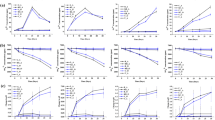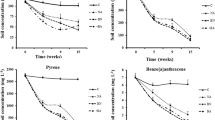Abstract
Acid mine drainage (AMD) is recognized as one of the most serious contamination sources in the nonferrous metal mining industry. In this study, aerobic strains VCZ02 and VCZ09, which were identified as Leclercia adecarboxylata and Klebsiella aerogenes, were screened from 11 strains of copper-zinc-resistant bacteria in the soil of the Dexing copper mine with Cu2+/Zn2+ removal rates of 46.32%/41.03% and 57.96%/67.05%, respectively. The composition of extracellular polymers plays an important role in the removal of heavy metals by these two strains. A mixed community consisting of VCZ02 and VCZ09 was coupled with Sagittaria trifolia L.var.sinensis (Sims) Mak to construct a microbial-plant coupled reactor to remediate AMD. Under the optimal condition of sodium acetate as carbon source, the pH of AMD increased from less than 5 to above 6.5, showing Cu2+/Zn2+ removal rates of 70–80% and above 30%, respectively. SEM–EDS results showed that VZC02 and VZC09 in the coupled reactor also helped with resisting the toxicity of heavy metals to plants by forming biofilms on the root surface and increasing the content of heavy metals on the surface of roots, thus improving the treatment effect of plants. This study provides a theoretical basis for the bioremediation of AMD and its application.







Similar content being viewed by others
Data availability
Not applicable.
References
Asad SA, Muhammad F, Aftab A, Helen W (2019) Integrated phytobial heavy metal remediation strategies for a sustainable clean environment - A review. Chemosphere 217:925–941
Buapet P, Mohammadi NS, Pernice M, Kumar M, Kuzhiumparambil U, Ralph PJ (2019) Excess copper promotes photoinhibition and modulates the expression of antioxidant-related genes in Zostera muelleri. Aquat Toxicol 207:91–100
Cui D, Shen D, Wu C, Li C, Leng D, Zhao M (2017) Biodegradation of aniline by a novel bacterial mixed culture AC. Int Biodeter Biodegr 125:86–96
Cui H, Zhang C, Li C, Lin L (2020) Inhibition of Escherichia coli O157: H7 biofilm on vegetable surface by solid liposomes of clove oil. LWT-Food Sci Technol 117:108656
Danish S, Kiran S, Fahad S et al (2019) Alleviation of chromium toxicity in maize by Fe fortification and chromium tolerant ACC deaminase producing plant growth promoting rhizobacteria. Ecotox Environ Safe 185:109706
Elssaidi MA, Alshebani AK (2012) Bio-Remediation of contaminated soils with petroleum hydrocarbons and their suitable environmental and biological conditions. Environ Biol Sci 1(1):13–14
Gallardo-Rodríguez JJ, Rios-Rivera AC, Bennevitz MRV (2019) Living biomass supported on a natural-fiber biofilter for lead removal. J Environ Manage 231:825–832
Gupta N, Ram H, Kumar B (2016) Mechanism of Zinc absorption in plants: uptake, transport, translocation and accumulation. Rev Environ Sci Bio 15(1):89–109
Han Y, Yin D, Jia M, Wang S, Chen Y, Rathinasabapathi B, Chen D, Ma Q (2019) Arsenic-resistance mechanisms in bacterium Leclercia adecarboxylata strain As3-1: Biochemical and genomic analyses. Sci Total Environ 690:1178–1189
He J, Chen JP (2014) A comprehensive review on biosorption of heavy metals by algal biomass: Materials, performances, chemistry, and modeling simulation tools. Bioresour Technol 160:67–78
Hughes TA, Gray NF, Guillamón OS (2013) Removal of metals and acidity from acid mine drainage using liquid and dried digested sewage sludge and cattle slurry. Mine Water Environ 32(2):108–120
Ighalo JO, Kurniawan SB, Iwuozor KO, Aniagor CO, Ajala OJ, Oba SN, Igwegbe CA (2022) A review of treatment technologies for the mitigation of the toxic environmental effects of acid mine drainage (AMD). Process Saf Environ 157:37–58
Jain VM, Karibasappa GN, Dodamani AS, Mali GV (2017) Estimating the carbohydrate content of various forms of tobacco by phenol-sulfuric acid method. J Educ Health Promot 6:90
Kang C, Kwon Y, So J (2016) Bioremediation of heavy metals by using bacterial mixtures. Ecol Eng 89:64–69
Karatay SE, Dönmez G (2014) An economical phenol bioremoval method using Aspergillus versicolor and agricultural wastes as a carbon source. Ecol Eng 73:224–228
Kumawat KC, Sharma P, Singh I, Sirari A, Gill BS (2019) Co-existence of Leclercia adecarboxylata (LSE-1) and Bradyrhizobium sp. (LSBR-3) in nodule niche for multifaceted effects and profitability in soybean production. World J Microbiol Biotechnol 35(11):172
Le Pape P, Fabienne B, Marc P, Catherine J, Cindy G (2017) Complete removal of arsenic and zinc from a heavily contaminated acid mine drainage via an indigenous SRB consortium. J Hazard Mater 321:764–772
Liu X, Zou G, Wang X, Zou L, Wen J, Ruan R, Wang D (2013) A novel low pH sulfidogenic bioreactor using activated sludge as carbon source to treat acid mine drainage (AMD) and recovery metal sulfides: Pilot scale study. Miner Eng 48:51–55
Liu J, Wang F, Wu W, Wan J, Yang J, Xiang S, Wu Y (2018) Biosorption of high-concentration Cu (II) by periphytic biofilms and the development of a fiber periphyton bioreactor (FPBR). Bioresource Technol 248:127–134
Masindi V, Chatzisymeon E, Kortidis I, Foteinis S (2018) Assessing the sustainability of acid mine drainage (AMD) treatment in South Africa. Sci Total Environ 635:793–802
Naik MM, Pandey A, Dubey SK (2012) Biological characterization of lead-enhanced exopolysaccharide produced by a lead resistant Enterobacter cloacae strain P2B. Biodegration 23(5):775–783
Nikaido H, Nakae T (1980) The outer membrane of Gram-negative bacteria. Adv Microb Physiol 20:163–250
Nogueira EW, de Godoi LAG, Yabuki LNM, Brucha G, Damianovic MHRZ (2021) Sulfate and metal removal from acid mine drainage using sugarcane vinasse as electron donor: Performance and microbial community of the down-flow structured-bed bioreactor. Bioresource Technol 330:124968
Nualla-Ong A, Phongdara A, Buapet P (2020) Copper and zinc differentially affect root glutathione accumulation and phytochelatin synthase gene expression of Rhizophora mucronata seedlings: Implications for mechanisms underlying trace metal tolerance. Ecotox Environ Safe 205:111175
Rani R, Kumar V, Gupta P, Chandra A (2019) Effect of endosulfan tolerant bacterial isolates (Delftia lacustris IITISM30 and Klebsiella aerogenes IITISM42) with Helianthus annuus on remediation of endosulfan from contaminated soil. Ecotox Environ Safe 168:315–323
Rudd T, Sterritt RM, Lester JN (1983) Mass balance of heavy metal uptake by encapsulated cultures of Klebsiella aerogenes. Microb Ecol 9(3):261–272
Rutgers M, Wouterse M, Drost SM, Breure AM, Mulder C, Stone D, Creamer RE, Winding A, Bloem J (2016) Monitoring soil bacteria with community-level physiological profiles using Biolog™ ECO-plates in the Netherlands and Europe. Appl Soil Ecol 97:23–35
Saranya K, Sundaramanickam A, Shekhar S, Meena M, Sathishkumar RS, Balasubramanian T (2018) Biosorption of multi-heavy metals by coral associated phosphate solubilising bacteria Cronobacter muytjensii KSCAS2. J Environ Manage 222:396–401
Sheoran AS, Sheoran V, Choudhary RP (2010) Bioremediation of acid-rock drainage by sulphate-reducing prokaryotes: a review. Miner Eng 23(14):1073–1100
Shi J, Zhang B, Cheng Y, Peng K (2020) Microbial vanadate reduction coupled to co-metabolic phenanthrene biodegradation in groundwater. Water Res 186:116354
Shirinpur-Valadi A, Hatamzadeh A, Sedaghathoor S (2019) Study of the accumulation of contaminants by Cyperus alternifolius, Lemna minor, Eichhornia crassipes, and Canna × generalis in some contaminated aquatic environments. Environ Sci Pollut R 26(21):21340–21350
Singh S, Chakraborty S (2020) Performance of organic substrate amended constructed wetland treating acid mine drainage (AMD) of North-Eastern India. J Hazard Mater 397:122719
Singh S, Chakraborty S (2022) Biochemical treatment of coal mine drainage in constructed wetlands: Influence of electron donor, biotic–abiotic pathways and microbial diversity. Chem Eng J 440:135986
Soda S, Hamada T, Yamaoka Y, Ike M, Nakazato H, Saeki Y, Kasamatsu T, Sakurai Y (2012) Constructed wetlands for advanced treatment of wastewater with a complex matrix from a metal-processing plant: Bioconcentration and translocation factors of various metals in Acorus gramineus and Cyperus alternifolius. Ecol Eng 39:63–70
Sricoth T, Weeradej M, Patompong S, John P, Puntaree T (2018) Aquatic plants for phytostabilization of cadmium and zinc in hydroponic experiments. Environ Sci Pollut R 25(15):14964–14976
Teng Z, Chen Z, Zhang Q, Yao Y, Song M, Li M (2019) Isolation and characterization of phosphate solubilizing bacteria from rhizosphere soils of the Yeyahu Wetland in Beijing. China Environ Sci Pollut Res Int 26(33):33976–33987
Teng Z, Shao W, Zhang K, Yu F, Huo Y, Li M (2020) Enhanced passivation of lead with immobilized phosphate solubilizing bacteria beads loaded with biochar/ nanoscale zero valent iron composite. J Hazard Mater 384:121505
Wen Q, Wang Q, Li X, Chen Z, Tang Y, Zhang C (2018) Enhanced organics and Cu2+ removal in electroplating wastewater by bioaugmentation. Chemosphere 212:476–485
Xu X, Shi G, Jia R (2012) Changes of polyamine levels in roots of Sagittaria sagittifolia L. under copper stress. Environ Sci Pollut Res 19(7):2973–2982
Yang J, Liu J, Wu C, Kerr PG, Wong P, Wu Y (2016) Bioremediation of agricultural solid waste leachates with diverse species of Cu (II) and Cd (II) by periphyton. Bioresource Technol 221:214–221
Yazdi M, Kolahi M, Kazemi EM, Barnaby AG (2019) Study of the contamination rate and change in growth features of lettuce (Lactuca sativa Linn.) in response to cadmium and a survey of its phytochelatin synthase gene. Ecotox Environ Safe 180:295–308
Yin Y, Hu Y, Xiong F (2011) Sorption of Cu(II) and Cd(II) by extracellular polymeric substances (EPS) from Aspergillus fumigatus. Int Biodeter Biodegr 65(7):1012–1018
Zeng Z, Guo X, Xu P, Xiao R, Huang D, Gong X, Cheng M, Yi H, Li T, Zeng G (2018) Responses of microbial carbon metabolism and function diversity induced by complex fungal enzymes in lignocellulosic waste composting. Sci Total Enviro 643:539–547
Zeng W, Li F, Wu C, Yu R, Wu X, Shen L, Liu Y, Qiu G, Li J (2020) Role of extracellular polymeric substance (EPS) in toxicity response of soil bacteria Bacillus sp. S3 to multiple heavy metals. Bioprocess Biosyst Eng. 43(1):153–167
Zhalnina K, Louie KB, Hao Z et al (2018) Dynamic root exudate chemistry and microbial substrate preferences drive patterns in rhizosphere microbial community assembly. Nat Microbiol. 3(4):470–480
Zhang M (2011) Adsorption study of Pb(II), Cu(II) and Zn(II) from simulated acid mine drainage using dairy manure compost. Chem Eng J 172(1):361–368
Zhou Q, Yang N, Li Y, Ren B, Ding X, Bian H, Yao X (2020) Total concentrations and sources of heavy metal pollution in global river and lake water bodies from 1972 to 2017. Glob Ecol Conserv 22:e00925
Acknowledgements
This study was funded by the National Key R&D Program of China (2019YFC1805002) and the National Natural Science Foundation of China (51874018).
Funding
This study was funded by the National Key R&D Program of China (2019YFC1805002) and the National Natural Science Foundation of China (51874018).
Author information
Authors and Affiliations
Contributions
Conceptualization: Hai Lin. Methodology: Hai Lin. Formal analysis and investigation: Hai Lin. Writing original draft preparation: Yalu Tang. Writing, review, and editing: Yalu Tang. Funding acquisition: Yingbo Dong. Resources: Yingbo Dong. Supervision: Yingbo Dong.
Corresponding author
Ethics declarations
Ethics approval and consent to participate
Not applicable.
Consent for publication
Not applicable.
Competing interests
The authors declare no competing interests.
Additional information
Communicated by Elena Maestri
Publisher's note
Springer Nature remains neutral with regard to jurisdictional claims in published maps and institutional affiliations.
Supplementary Information
Below is the link to the electronic supplementary material.
Rights and permissions
About this article
Cite this article
Lin, H., Tang, Y. & Dong, Y. Construction and carbon source optimization of a microbial-plant coupled reactor for treating acid mine drainage. Environ Sci Pollut Res 29, 78862–78873 (2022). https://doi.org/10.1007/s11356-022-21329-0
Received:
Accepted:
Published:
Issue Date:
DOI: https://doi.org/10.1007/s11356-022-21329-0




